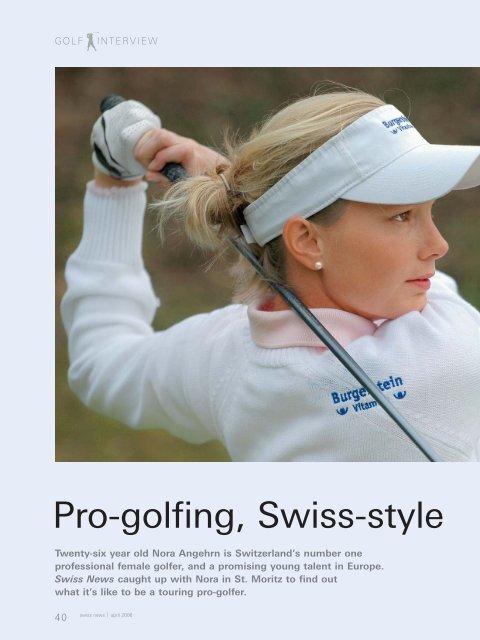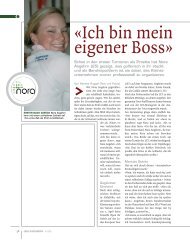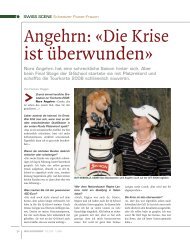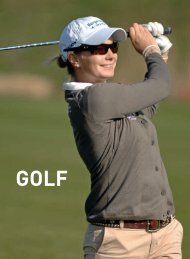Layout 1 (Page 40) - Nora Angehrn
Layout 1 (Page 40) - Nora Angehrn
Layout 1 (Page 40) - Nora Angehrn
Create successful ePaper yourself
Turn your PDF publications into a flip-book with our unique Google optimized e-Paper software.
GOLF<br />
INTERVIEW<br />
Pro-golfing, Swiss-style<br />
Twenty-six year old <strong>Nora</strong> <strong>Angehrn</strong> is Switzerland’s number one<br />
professional female golfer, and a promising young talent in Europe.<br />
Swiss News caught up with <strong>Nora</strong> in St. Moritz to find out<br />
what it’s like to be a touring pro-golfer.<br />
<strong>40</strong><br />
swiss news ⏐ april 2006
GOLF<br />
INTERVIEW<br />
seven European Amateur Team Championships, three World<br />
Amateur Championships, and was the Swiss Amateur Champion<br />
in 2000, 2001 and 2004.<br />
Going pro<br />
For European women to become pro-golfers, they must attend<br />
and finish in the top 30 positions at Qualifying School – Q-<br />
school – to gain their playing card for the Ladies European Tour<br />
(LET). Finishing in the top 30 allows competitors to play in almost<br />
every professional European tournament during the following<br />
year.<br />
<strong>Nora</strong> competed at Q-school for the first time in November<br />
2004, almost on a whim, she says, to try her hand at the competition<br />
and see how she would do. She ended up shooting the<br />
lowest round of the week with a final round five-under-par 67,<br />
which catapulted her from 20 th position to 3 rd and ensured her a<br />
full playing card for the LET in the 2005 season.<br />
Counting that day as one of her greatest golf successes to<br />
date, she says: “My adrenaline was racing during that round. It<br />
was a great way to turn pro.”<br />
Between the ears<br />
However, turning pro meant that <strong>Nora</strong>’s hobby had become her<br />
profession. “Because golf is my job, there is more pressure than<br />
when I was an amateur.”<br />
She now has sponsorship, which she calls one of the most<br />
important factors in pro-golf. But with sponsors, comes the<br />
added responsibility of representing them well, while continually<br />
improving the standard of her golf.<br />
After a tough year in 2005 that saw her return to Q-school<br />
to regain her card, <strong>Nora</strong>’s attitude is positive. “For me, fun is the<br />
most important part of whatever I do.<br />
“Currently, I am working on the mental side. Many people<br />
say that at a certain level, golf is all between your ears. I am just<br />
trying to get better each year.<br />
“As long as I have fun, keep my card, keep the sponsors happy<br />
and make a living, then I’ll do it.”<br />
<strong>Nora</strong> has been playing sports since she could walk and golfing<br />
since the age of ten. “When I was young, I played ice hockey,<br />
basketball, floor hockey, basically anything with a ball. You<br />
name it and I played it.”<br />
When her parents started going to the golf course on Sundays,<br />
“they said I could come with them or stay home by myself.<br />
So I decided to go with them. I caddied for my dad and started<br />
playing too. It was cool, but not ‘oh wow, I love it’.” Well, not at<br />
first, that is.<br />
<strong>Nora</strong> displayed natural talent for golf, and her annual improvement<br />
meant that at the age of 14 she was selected for the<br />
Swiss National Team. As an amateur, she went on to compete in<br />
On the ball: golfing here and abroad<br />
The difference between the US and Switzerland, says <strong>Nora</strong>, is<br />
that everyone can play golf in the States.<br />
“And that is awesome. But of course, the disadvantage of going<br />
to a public course in the US is that it may take six hours to<br />
play 18 holes because the people in front of you can’t play,” she<br />
says with a laugh.<br />
<strong>Nora</strong> usually spends 1-2 months during the winter in Florida,<br />
practising with her Canadian coach, Denise Lavigne. This<br />
year, she trained in the West Palm Beach golf area.<br />
Contrary to popular belief, training for the pros doesn’t mean<br />
playing a round of golf every other day. “That would be great<br />
though,” she says. “I go to the driving range and hit balls for two<br />
hours. It’s not really fun, because the shots I am hitting are bad,<br />
but it is a little part of the swing that I’m actually working on. Or<br />
I putt for two hours to work on one minor part of my game.”<br />
When she wasn’t training in Florida, <strong>Nora</strong> did manage to get<br />
in a few rounds. “Playing in the States is definitely more easygoing<br />
than here. And it can be more fun. On the course, the cart<br />
girl comes by with beer, everyone’s laughing, and I get the<br />
chance to meet and talk with many different people.”<br />
<strong>Nora</strong> says there is still a bit of an elitest attitude in Switzerland<br />
surrounding golf. “People think playing golf is snobby. I<br />
swiss news ⏐ april 2006<br />
41
© Photos by Hannes Huggel<br />
“At a certain level, golf is all between your ears.”<br />
Promising start<br />
<strong>Nora</strong> began the 2006 season by becoming the first Swiss to win<br />
the Pam Goldings Ladies International held at the end of February<br />
in Johannesburg, South Africa. “We all want to play,” she<br />
says. “Most European players head to South Africa because we<br />
don’t have a [European] tour until the end of April.”<br />
The tournament marks her second professional win, and is<br />
certainly the way she hoped to start her season, taking home<br />
SFr 9,000 in prize money. “My sponsors pay the expense of going,<br />
but any money I win, I pocket,” she says.<br />
<strong>Nora</strong>’s next competition at home will be an important one<br />
as the LET comes to Switzerland this May for the first time since<br />
1997. The Golf Gerre Losone course, located between Locarno<br />
and Ascona, will host the Duetsche Bank Ladies’ Swiss Open<br />
from May 18-21.<br />
Playing alongside <strong>Nora</strong> will be Switzerland’s two other professional<br />
women golfers – Florence Lüscher and Frédérique<br />
Seeholzer – together with at least four of the top amateur players,<br />
who will be nominated by the Association Suisse de Golf<br />
(ASG) to represent the Swiss nation.<br />
This contest will mark <strong>Nora</strong>’s first professional LET event in<br />
her home country – a competition that she is hoping to shine in.<br />
“The pressure’s going to be on, of course, but I won the pro-am<br />
(Losone International) on that course, so I like it.”<br />
With over 500,000 in prize money, 75,000 alone going to<br />
the first place winner, <strong>Nora</strong> has many reasons to play her best.<br />
And, as an added bonus, the winner earns a spot in the LET for<br />
the remainder of 2006 and the following three seasons.<br />
To cheer <strong>Nora</strong> on at Golf Gerre Losone, take the train to Locarno,<br />
and then hop on bus 36 to Losone. Take the bus to the<br />
end of the line, and then follow the signs to the course, which is<br />
about a 15-minute walk away.<br />
By Kati Clinton<br />
remember when I was young, I was almost embarrassed to tell<br />
my friends that I was going to Zumikon [golf course].”<br />
And of course, there’s the matter of space. “We don’t have<br />
enough space. Everything is tight. It’s supply and demand and<br />
we can’t keep up.”<br />
Playing with the best<br />
Once she has established herself on the LET, <strong>Nora</strong> has set herself<br />
some ambitious goals. The biggest is to represent Europe in the Solheim<br />
Cup, though she also aspires to play on the LPGA tour; a tour<br />
she believes holds the highest standard of female golf in the world.<br />
“The talent is amazing,” she says, “the prize money is triple at<br />
least, and the marketing is way ahead of Europe. I would say that<br />
the LET today is like the LPGA was seven years ago.”<br />
There is a new trend for women golfers, especially in the US,<br />
to compete in men’s tournaments, for example Annika Sörenstam<br />
at the Colonial in 2003. And even though she didn’t make<br />
the cut, <strong>Nora</strong> believes “the thing Annika did was very cool.”<br />
“She is the number one female golfer in the world, so she entered<br />
the men’s tournament as a one-time thing – to see if she was<br />
good enough, if she could compete on that level.” And her actions<br />
certainly were good for the visibility of women’s golf.<br />
While <strong>Nora</strong> respects Sörenstam, she doesn’t seek to replicate<br />
the career of one specific golfer. “I don’t really admire just one<br />
golfer. I admire different aspects. I admire Tiger for his mental<br />
toughness, and Adam Scott for his swing.”<br />
42<br />
swiss news ⏐ april 2006<br />
Wanna go pro in Switzerland<br />
For European women to become pro-golfers,<br />
they must attend and finish in the top 30<br />
positions at Qualifying School to gain their<br />
playing card for the Ladies European<br />
Tour (LET). Finishing in the top 30 allows<br />
competitors to play in almost every<br />
professional European tournament during the<br />
following year. However, if a competitor’s<br />
ranking at the end of the following year falls<br />
too low, she will have to compete in<br />
Q-school again to re-win her card.<br />
Women ranked in the top 90 in Europe<br />
are automatically exempt from Q-school<br />
and retain their cards for the next year.<br />
Women ranked in the next 45 or so places<br />
in Europe return to Q-school, but are<br />
exempt from the pre-qualifying round, and<br />
begin play at the final stage.<br />
Around 150 women compete in the LET<br />
Q-school each year. First time competitors,<br />
as well as women who have lost their cards<br />
from previous seasons, have to play<br />
in a 36-hole competion to advance to the<br />
qualifying round.<br />
Successful competitors then join the 45<br />
or so players who were already exempt, to<br />
make a field of 90 – plus ties – for the final<br />
qualifying stage. The final stage consists<br />
of a 54-hole competition, with the top 30<br />
competitors winning full playing cards.





